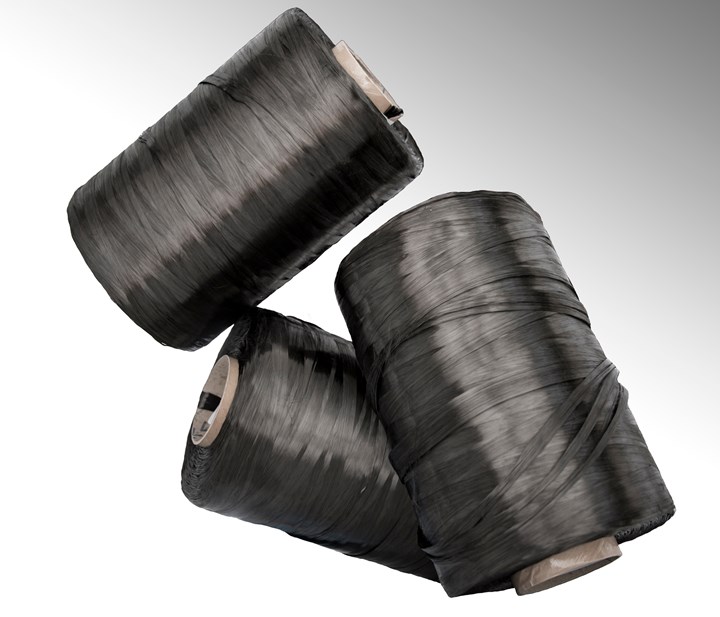"Green" carbon fiber: Renewable energy powers fiber production
Zoltek is first in the industry to use “green” electricity to produce a portion of its heavy-tow carbon fiber.

At its sprawling Nyergesújfalu plant in Hungary, Zoltek Companies Inc. has just started using electricity produced from renewable resources to help produce “green” carbon fiber. With annual production capacity of 15,000 metric tons, the facility is said to be the world’s largest fully integrated carbon fiber plant where polyacrylonitrile (PAN) precursor, carbon fiber itself and downstream, value-added carbon fiber-based intermediates like fabrics and pultruded goods are all produced at a single site. Source | Zoltek
Zoltek Companies Inc. (St. Louis, Missouri, U.S.) is the first carbon fiber producer to use green energy — electricity produced from renewable resources such as wind turbines — to manufacture a portion of its global carbon fiber production.
At the start of the year, Zoltek’s facility in Nyergesújfalu, Hungary began using electricity from renewable resources to power everything from precursor production, to ovens used to carbonize precursor on the way to producing carbon fiber, to intermediate products made from the carbon fiber. “The green electricity is being used for every step of the process, from the moment our raw material enters our facility until the moment the finished carbon fiber leaves as part of a shipment to a customer,” explains Tobias Potyra, Zoltek global automotive director.
This switch in energy sources — at a cost premium that will be borne by Zoltek and not passed on to customers — is estimated to save 5,000 metric tons of carbon dioxide (CO2) annually versus electricity generated by burning coal or natural gas. The plant’s local electricity supplier will issue CO2 certificates to Zoltek based on actual consumption at year’s end.
The significance of this step becomes clearer when the size of the Nyergesújfalu facility it considered. It has an annual capacity of 15,000 metric tons and is said to be the world’s largest fully integrated carbon fiber plant where polyacrylonitrile (PAN) precursor, carbon fiber itself, and downstream, value-added carbon fiber-based intermediates like fabrics and pultruded goods are all produced at a single site. Given how energy-intensive carbon fiber production is, let’s hope that other carbon fiber producers follow suit.

Although it still looks black, a portion of Zoltek’s total global output of industrial-grade (heavy-tow) carbon fiber has just become greener thanks to use of electricity produced from renewable resources that helps offset the greenhouse gases normally generated when electricity is produced by burning coal or natural gas. Source | Török Brigi / BrigiPix Média
Reportedly, the change is being made as part of Zoltek’s internal efforts to focus on sustainability in all areas of its business. “Our carbon fibers enable wind energy to compete with fossil fuels, automobiles to be lighter weight, and batteries to be more efficient, so the shift to renewables to power our own precursor and carbon fiber manufacturing was the next logical step,” explains David Purcell, Zoltek executive vice president. “The proactive use of renewable energy aligns with both our own corporate philosophy as well as the philosophies of many of the industries we serve across the globe whose products already benefit the environment.”
“At Zoltek, we focus every day on ways to make life better for future generations,” adds Nobuya Ando, Zoltek CEO and president. “Using green energy is our responsibility to our customers, our shareholders, and everyone in our communities.”
Zoltek is the global producer of lower-cost, industrial-grade (heavy-tow) carbon fiber and carbon fiber-based intermediates for automotive, wind energy, thermoplastic compounding, offshore drilling, civil engineering, marine and other industrial segments. It was acquired by Toray Group (Tokyo, Japan) in 2014.
Related Content
Jeep all-composite roof receivers achieve steel performance at low mass
Ultrashort carbon fiber/PPA replaces steel on rooftop brackets to hold Jeep soft tops, hardtops.
Read MorePEEK vs. PEKK vs. PAEK and continuous compression molding
Suppliers of thermoplastics and carbon fiber chime in regarding PEEK vs. PEKK, and now PAEK, as well as in-situ consolidation — the supply chain for thermoplastic tape composites continues to evolve.
Read MoreThe lessons behind OceanGate
Carbon fiber composites faced much criticism in the wake of the OceanGate submersible accident. CW’s publisher Jeff Sloan explains that it’s not that simple.
Read MoreComposites manufacturing for general aviation aircraft
General aviation, certified and experimental, has increasingly embraced composites over the decades, a path further driven by leveraged innovation in materials and processes and the evolving AAM market.
Read MoreRead Next
All-recycled, needle-punched nonwoven CFRP slashes carbon footprint of Formula 2 seat
Dallara and Tenowo collaborate to produce a race-ready Formula 2 seat using recycled carbon fiber, reducing CO2 emissions by 97.5% compared to virgin materials.
Read MoreVIDEO: High-volume processing for fiberglass components
Cannon Ergos, a company specializing in high-ton presses and equipment for composites fabrication and plastics processing, displayed automotive and industrial components at CAMX 2024.
Read MoreDeveloping bonded composite repair for ships, offshore units
Bureau Veritas and industry partners issue guidelines and pave the way for certification via StrengthBond Offshore project.
Read More
.jpg;width=70;height=70;mode=crop)























